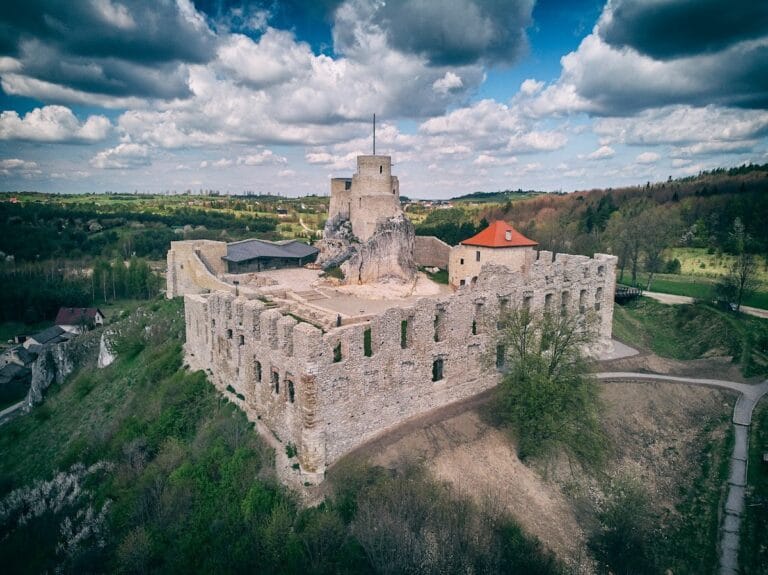Ojców Castle: A Medieval Fortress in Poland’s Kraków-Częstochowa Upland
Visitor Information
Google Rating: 4.2
Popularity: Medium
Google Maps: View on Google Maps
Official Website: www.ojcowskiparknarodowy.pl
Country: Poland
Civilization: Unclassified
Remains: Military
History
Ojców Castle is located in the municipality of Ojców, Poland, and was built by the medieval Polish kingdom. Constructed between 1354 and 1370 under the command of King Casimir III the Great, the fortress was part of a defensive line known as the “Eagle’s Nests.” These fortifications were established in the Kraków-Częstochowa Upland to protect the western frontiers of the kingdom. The castle’s earliest recorded mention dates to 1370, when a castellan named Zaklika was appointed to oversee it.
The name originally used for the site, “Ociec,” is traditionally linked to King Casimir III, who is said to have named the castle in honor of his father, King Władysław Łokietek. Historical accounts recount that Łokietek sought refuge in nearby caves during his conflicts over the Kraków throne. Throughout its history, Ojców Castle served as the center of an administrative district called a starostwo, specifically a non-grod (non-fortified) one, until the late 18th century. Over the centuries, the castle was leased and owned by several noble families, including Jan de Kozcow and the Szafraniec, Mężyk, Myszkowski, Koryciński, and Załuski lineages.
By the early 1600s, the castle had fallen into disrepair, yet it escaped destruction during the Swedish Deluge in the mid-17th century. During this conflict, Swedish soldiers used it mainly as a storage facility. Beginning in 1620, the Koryciński family undertook partial restoration efforts to maintain the structure. In 1787, the last starost, Teofil Wojciech Załuski, welcomed King Stanisław August Poniatowski, who attended a baptism held in the castle chapel for his daughter.
The castle was abandoned in 1802, with all its movable possessions removed. Subsequently, in 1829, Konstanty Wolicki acquired the property and began dismantling parts of the castle walls due to concerns about their stability. He left only the octagonal tower, the gate, and some sections of the lower perimeter intact. During the late 19th century, owners such as Ludwik Krasiński and his daughter Maria Ludwika Krasińska initiated some repairs, mainly addressing the tower and gate, but a full-scale reconstruction never took place.
The octagonal tower incurred damage in World War I and was repaired in 1935. Archaeological investigations and small-scale conservation work have been ongoing since the mid-20th century, with notable research led by the Institute of Archaeology at Jagiellonian University beginning in 2006. Between 2016 and 2019, a major restoration and revitalization project was carried out, including rebuilding wooden interior structures and adding a multimedia exhibition inside the tower. Today, Ojców Castle belongs to the Ojców National Park and stands as a preserved historic site with expanded access to its defensive tower and surrounding ruins.
Remains
Ojców Castle occupies a strategic position on Castle Hill within a forested national park, blending medieval defensive architecture with the natural landscape of the Kraków-Częstochowa Upland. The layout reflects typical features of 14th-century fortresses designed to guard border territories. The surviving structures include a dominant octagonal tower, a pointed Gothic gate passage, and remnants of the lower defensive walls encircling the castle.
The octagonal tower is the most prominent and best-preserved element. Originally taller, it was reduced in height by about six meters in 1892 due to structural concerns, though plans to restore it to full height were not realized. Constructed of sturdy stone masonry, the tower underwent extensive restoration from 2016 to 2019, receiving a new wooden shingle roof and reconstructed wooden frameworks inside, including staircases and floors on two levels. Windows have been installed where openings existed, allowing natural light into the interior. The tower now hosts a multimedia exhibition featuring historical films, with future installations planned to display replicas of medieval arms and armor.
The Gothic gate provides access through a pointed-arch passage that is characteristic of the period’s architectural style. Built with carefully cut stone, the gate served as a controlled entry point and part of the castle’s defensive system. Along with the tower, it was partially restored in the late 19th century, and conservation work has continued in recent decades.
Surrounding the tower and gate are the lower portions of perimeter defensive walls, which outline the castle’s original fortification circuit. These walls have endured centuries of wear and deliberate dismantling but remain in situ, offering insight into the castle’s scale and defensive layout. Over time, the walls have seen minor preservation efforts to maintain their condition.
Modern additions include steel stairs that provide access to the tower and a viewing platform installed atop the remnants of the castle’s residential area, allowing visitors to survey the landscape. Archaeological excavations have been carried out in and around the castle since the early 1990s, with significant research campaigns led by Michał Wojenka from 2006 onward. These studies have helped clarify the castle’s construction phases and usage over time.
Ojców Castle is an integral part of the “Eagle’s Nests” chain of fortresses, and its remains reflect both the medieval defensive strategies employed by the Polish kingdom and the layered history of ownership, conflict, and conservation that has shaped the site through the centuries.










